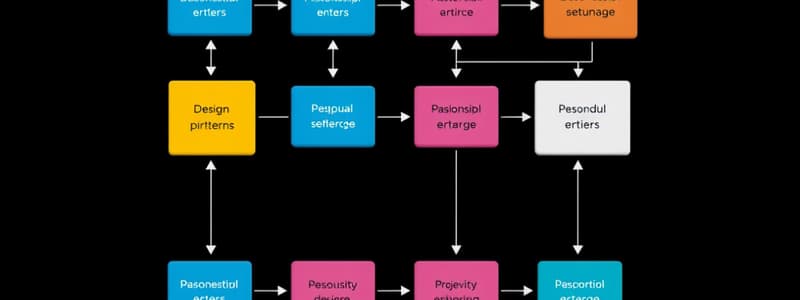Podcast
Questions and Answers
Which component is essential for ensuring that vehicles meet legal safety standards?
Which component is essential for ensuring that vehicles meet legal safety standards?
- Load Compliance Checks
- Driver Awareness Training
- Incident Reporting Protocols
- Vehicle Inspections (correct)
What is a critical purpose of using electronic logging devices (ELDs) in compliance checks?
What is a critical purpose of using electronic logging devices (ELDs) in compliance checks?
- To track the vehicle's fuel consumption
- To manage vehicle maintenance schedules
- To monitor the vehicle's GPS location
- To record driving hours and rest periods (correct)
Which best practice focuses on ensuring all stakeholders actively share information about safety and compliance?
Which best practice focuses on ensuring all stakeholders actively share information about safety and compliance?
- Clear Communication (correct)
- Regular Audits
- Training and Awareness Programs
- Incident Management Plans
What practice is emphasized to help organizations prepare for accidents or compliance breaches?
What practice is emphasized to help organizations prepare for accidents or compliance breaches?
Which of the following is not a key component of compliance checks for drivers?
Which of the following is not a key component of compliance checks for drivers?
What is the primary aim of compliance checks for drivers?
What is the primary aim of compliance checks for drivers?
Which best practice is crucial for ensuring safety and compliance across all stakeholders?
Which best practice is crucial for ensuring safety and compliance across all stakeholders?
What is a significant benefit of using electronic logging devices (ELDs) for drivers?
What is a significant benefit of using electronic logging devices (ELDs) for drivers?
Which of the following would not be considered a best practice in preparing for compliance breaches?
Which of the following would not be considered a best practice in preparing for compliance breaches?
How can fatigue among drivers impact compliance with safety standards?
How can fatigue among drivers impact compliance with safety standards?
Study Notes
Chain of Responsibility
Implementation Strategies
- Define Handlers: Create an abstract handler class that includes a member variable to hold the next handler in the chain.
- Concrete Handlers: Implement concrete handler classes that inherit from the abstract handler. Each class should implement the handling logic and decide whether to pass the request to the next handler.
- Request Handling: Each handler receives the request, processes it if applicable, or forwards it to the next handler in the chain.
- Chain Setup: Establish the chain by linking handlers together in a specific order, ensuring the first handler in the chain is set to receive requests.
- Client Interaction: The client sends a request to the first handler in the chain. The request travels through the chain until it’s handled or reaches the end.
Pros
- Decoupling: Promotes loose coupling by allowing handlers to be independent, making it easier to add or change handlers without affecting others.
- Flexibility: The chain can be dynamically changed at runtime, enabling different behaviors based on varying conditions.
- Single Responsibility: Each handler focuses on a specific task, adhering to the Single Responsibility Principle.
- Easier Maintenance: Adding new handlers or modifying existing ones is straightforward, resulting in better maintainability.
Cons
- Performance Overhead: Multiple handler invocations can lead to performance issues, especially with long chains.
- Complexity in Debugging: Tracing the flow of requests through multiple handlers can complicate debugging and error handling.
- Potential for Unhandled Requests: If not carefully configured, requests may pass through the entire chain without being handled, resulting in failures.
- Difficulty in Understanding Logic: The chain can become convoluted, making it challenging for new developers to grasp the overall flow of request handling.
Implementation Strategies
- Define an abstract handler class with a member variable for the next handler to establish a linked chain structure.
- Create concrete handler classes that inherit from the abstract class, each implementing specific handling logic.
- Each handler processes requests applicable to it and either completes the request or forwards it to the next handler.
- Set up the chain by linking handlers in a defined order, ensuring the chain's first handler is ready to receive requests.
- Clients initiate requests by sending them to the first handler; the request travels through the chain until handled or reaches the end.
Pros
- Decoupling allows handlers to remain independent, facilitating the addition or modification of handlers without affecting others.
- The chain can be modified at runtime, offering flexibility to adapt to different conditions and behaviors.
- Adhering to the Single Responsibility Principle, each handler is focused on a specific task, enhancing clarity.
- Maintenance becomes easier as the system allows straightforward addition or modification of handlers.
Cons
- Performance can be impacted due to the overhead from multiple handler invocations, particularly in long chains.
- Debugging can be complex as tracing requests through a multitude of handlers presents challenges in error handling.
- Improper configuration can lead to unhandled requests that traverse the entire chain without resolution, causing failures.
- The chain’s structure can become convoluted, potentially confusing new developers about the request handling flow.
Chain of Responsibility for Drivers
Compliance Checks
- Ensures adherence of all parties to legal and safety regulations concerning transport of goods.
- Documentation Review: Involves confirming licenses, permits, and driver training credentials to establish eligibility.
- Vehicle Inspections: Routine examinations focus on essential functions such as brakes, lights, and tires to guarantee vehicle safety.
- Load Compliance: Verifies that load weights are within legal limits and secured properly, preventing potential hazards during transport.
- Driver Monitoring: Employing electronic logging devices (ELDs) helps to safeguard legal driving hours and mandated rest periods.
- Incident Reporting: Localized protocols are set for immediate reporting of accidents or violations to promote swift response.
Best Practices
- Emphasis on Training and Awareness: Ongoing training educates drivers and operators on their legal responsibilities and safety measures.
- Conducting Regular Audits: Periodic assessments assess compliance levels, identifying gaps, and facilitating risk management.
- Clear Communication: Essential for fostering transparent dialogue among all supply chain stakeholders, enhancing cooperation.
- Incident Management Plan: A structured response plan ensures quick and efficient handling of compliance breaches or accidents.
- Promoting a Safety Culture: Building an environment that prioritizes safety and compliance, recognizing and rewarding responsible practices.
- Use of Technology: Incorporating tracking and monitoring systems increases compliance and optimizes safety strategies.
- Keeping thorough Documentation: Accurate records of compliance checks, training activities, and incident reports are vital for accountability and improvement.
Chain of Responsibility Implementation Strategies
- Abstract handler class includes a member variable for the next handler in the chain.
- Concrete handler classes inherit from the abstract handler and implement specific handling logic.
- Handlers decide whether to process a request or forward it to the next handler.
- The chain is established by linking handlers in a defined order, with the first handler set to receive requests.
- Clients initiate requests to the first handler, which propagates the request through the chain.
Chain of Responsibility Pros
- Loose coupling allows for independent handlers, facilitating easier changes without impacting others.
- Dynamic chain modifications at runtime enable adaptable behaviors based on conditions.
- Adherence to the Single Responsibility Principle allows each handler to focus on a specific task.
- Straightforward addition of new handlers improves maintainability and reduces complexity.
Chain of Responsibility Cons
- Multiple invocations of handlers may induce performance overhead, particularly with lengthy chains.
- Debugging becomes complex due to the requirement to trace requests through numerous handlers.
- Requests may traverse the whole chain without being handled if configuration is inadequate, leading to failures.
- The logical flow can become convoluted, posing challenges for new developers to understand.
Chain of Responsibility for Drivers: Compliance Checks
- Compliance checks ensure adherence to legal and safety regulations in goods transport.
- Key components include:
- Documentation review encompassing licenses, permits, and training records.
- Regular vehicle inspections focusing on critical components like brakes, lights, and tires.
- Load compliance to verify legality in weight limits and securing of cargo.
- Driver monitoring utilizing electronic logging devices (ELDs) for tracking driving hours.
- Incident reporting procedures for immediate communication of accidents or violations.
Chain of Responsibility for Drivers: Best Practices
- Regular training on legal responsibilities and safety protocols enhances driver and operator awareness.
- Periodic audits of compliance help identify gaps and reduce associated risks.
- Clear communication channels among stakeholders foster effective supply chain collaboration.
- Incident management plans ensure preparedness for compliance breaches or accidents.
- A safety culture promotes responsible behavior and prioritizes safety among personnel.
- Use of technology, such as tracking and monitoring systems, boosts compliance and efficiency.
- Maintaining accessible records of compliance checks, training, and incidents facilitates accountability.
Studying That Suits You
Use AI to generate personalized quizzes and flashcards to suit your learning preferences.
Description
This quiz covers the Chain of Responsibility design pattern, focusing on its implementation strategies. It includes defining handlers, concrete implementations, request handling, chain setup, and client interaction. Test your understanding of how this pattern promotes decoupling and flexibility in programming.




